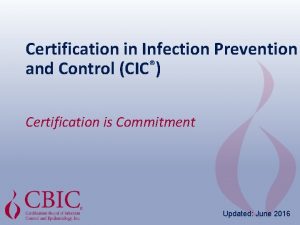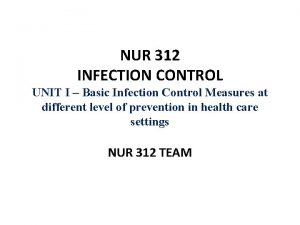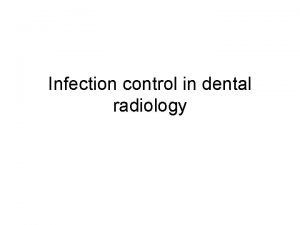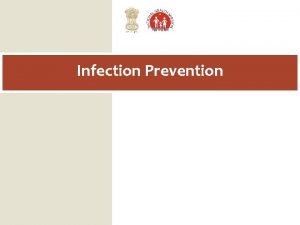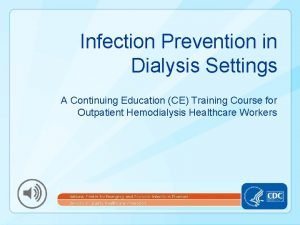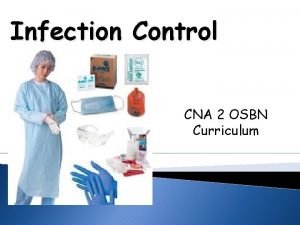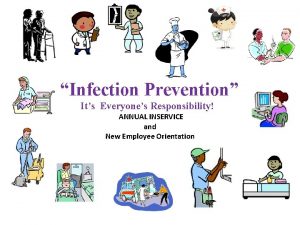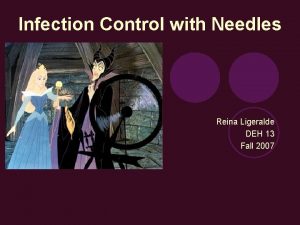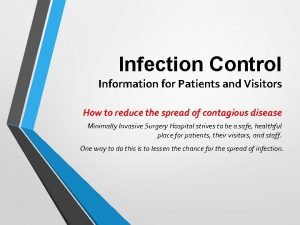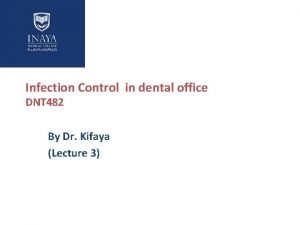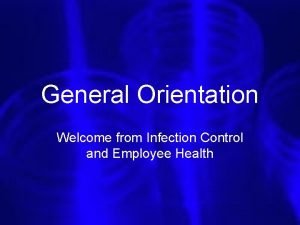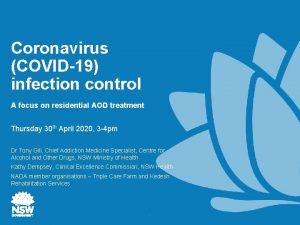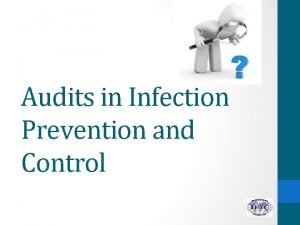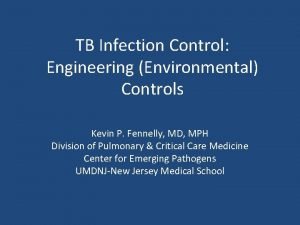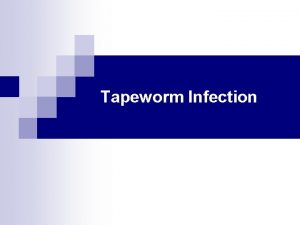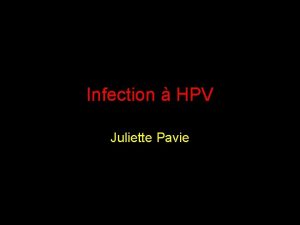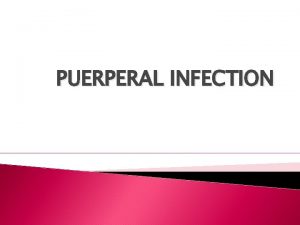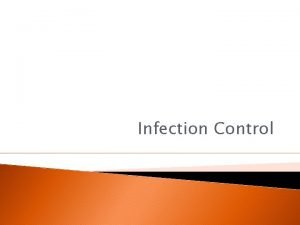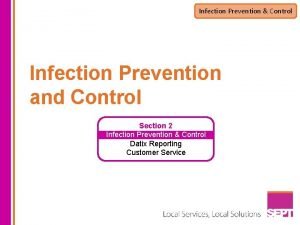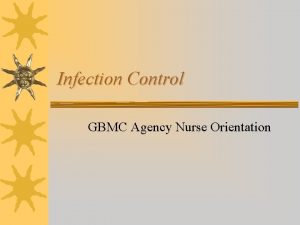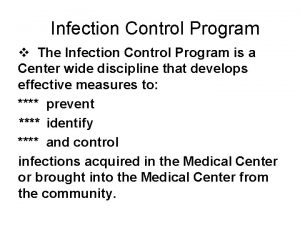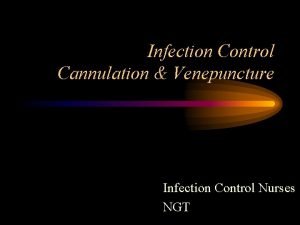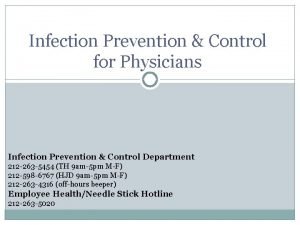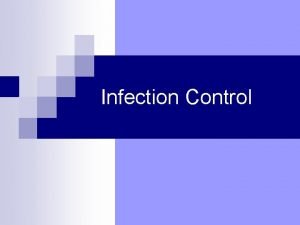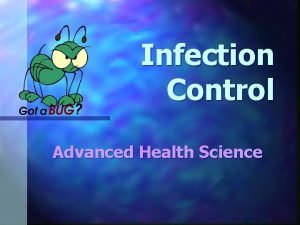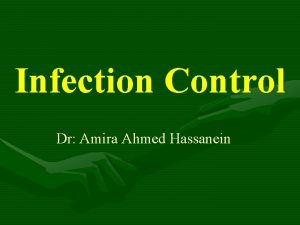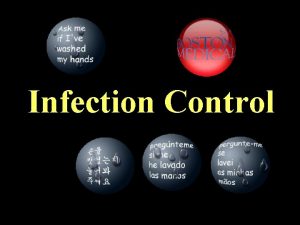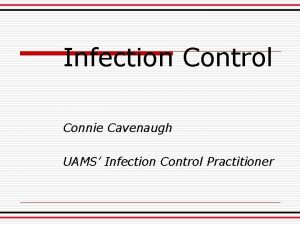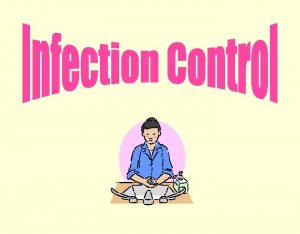Infection Control 101 Infection Control n n n






















- Slides: 22

Infection Control 101

Infection Control n n n Nosocomial vs. HAIs Standard Precautions “Protective environment” to prevent HAIs PPE (latex precautions) Biohazard Waste Transmission-based Isolation Precautions

Nosocomial vs. Healthcare Associated Infections (HAIs) n n Nosocomial - Infections acquired 72 hours after admission to a hospital HAIs infections associated with healthcare delivery in any setting

Standard precautions n n Infection control process that apply to all patients, regardless of suspected or confirmed infection status Based on the principle that all blood, body fluids, secretions, excretions excluding sweat, non-intact skin and mucous membranes may contain transmissible infectious agents

Standard precautions n n n Hand hygiene PPE depending on the anticipated exposures 4 Additional Areas of Practice

Standard precautions n Four “added” areas of practice: n n Respiratory Hygiene/Cough Etiquette Safe Injection Practices (re-emphasized) Use of masks for insertion of catheters or injections into the spinal or epidural spaces Use of a set of prevention measures termed Protective Environment, to prevent HAIs (e. g. , measures to decrease fungi in the environment; spatial distance >3 ft)

PPE – Personal Protective Equipment n n n Gloves clean vs. sterile Masks Gowns Booties Hairnets and surgical caps Goggles

Biohazard Waste Defined Any solid or liquid waste which may present a threat of infection to humans. It may include specimen containers, blood soaked bandages or dressings, and bloody gloves. Materials and substances found in laboratory and hospital waste which may contain disease-causing agents, such as tissue specimens, culture dishes and slides, body fluids, blood or blood products, sharps, and needles.

Red Bag Waste Disposal • Absorbant materials saturated with blood or bloody fluids, such as bandages, gauzes, sponges, lap sponges; • Non-absorbant disposable devices contaminated with blood or blood-contaminated body fluids, such as filled suction container liners, transfusion bags , IV tubing, drainage tubes; • Blood, blood products, excretions, secretions, tissue and body parts contaminated with blood.

Sharps Container Waste • Sharps • Needles • Scalpels • Blades • Glass or plastic slides • Culture tubes, dishes • Disposable Razors, • Disposable Scissors, • Broken glass ampules

Red Bag and Sharps Containers Sharps containers must be leak-proof, rigid, puncture-resistant, and not easily opened once sealed. They must be labeled BIOHAZARD with International Symbol. Must also be labeled with Facility address and phone number. (When Container 3/4 full, place DATE on container and replace). The Red “Infectious Waste” Bag must be plastic, impervious to moisture, strong enough to resist ripping, tearing or bursting. Bags must be securely tied when placed in storage. Must be labeled BIOHAZARD with International Symbol. Must also be labeled with Facility address and phone number.

Point of Origin • The healthcare professional generating the waste is responsible for its safe and proper disposal, and segregation at point of origin • Biohazard waste mixed with chemical waste must be handled and disposed of as hazardous waste; waste contaminated by chemotherapy waste, must be handled and disposed of as chemotherapy waste. Waste contaminated with radioactive material must be handled and disposed of as radioactive waste. • Biohazard Waste storage closets shall be visibly marked and inaccessible to the public.

Protect Yourself. . . When handling, transporting and disposing of Biohazard Red Bag or Sharps Containers Waste: • Keep bags AWAY from your body when carrying • Wear latex, vinyl or rubber gloves UNDER heavy duty reusable work gloves • Practice good hand hygiene: Wash with soap and water and/or use Alcare regularly and before break, eating, smoking, drinking, going home. • Wear a face shield or goggles when tossing bags into biohazard bin and outdoor dumpster • Cover bin in transit • Wear a disposable apron if chance of contamination of clothing • Report any “stick” or splash to Employee Health Nurse ASAP • Ask about getting a Hepatitis B Vaccine


Transmission-based ISOLATION • Contact • Droplet • Airborne • Protective

CONTACT PRECAUTIONS Gloves and gowns are required for ALL direct and indirect contact n Strict Handwashing technique n Handwashing + Alcohol Hand Rinse n Additional PPE as indicated n Visitors MUST wash hands BEFORE leaving. n

DROPLET PRECAUTIONS n n n Private room – door closed Regular masks when within 3 feet of patient With infective material will need: n Gloves n Gowns

DROPLET PRECAUTIONS n HANDWASHING n n After touching Patient After touching Potentially contaminated items Before taking care of another patient Contaminated items n n n Discard Bag and Label before being sent for decontamination and reprocessing.

AIRBORNE PRECAUTIONS n n n Private room – Negative Pressure Required (AIIR = Airborne Infection Isolation Room) HEPA Masks required at ALL times Contact with infective items/material require n n n Gowns Gloves Handwashing n n n After touching patient After handling potentially contaminated items Before caring for another patient

AIRBORNE PRECAUTIONS n n Pts. wear mask when leaving the room Contaminated Items n n Discard Bag and Label before decontamination/reprocessing

Protective Isolation n Used with immune compromised/susceptible patients Private room – full PPE Pts. wear mask when leaving the room

Let’s Practice
 Dental radiography techniques ppt
Dental radiography techniques ppt Standard precautions cosmetology
Standard precautions cosmetology Chapter 16 infection prevention and control
Chapter 16 infection prevention and control Chapter 16 infection control and standard precautions
Chapter 16 infection control and standard precautions Chapter 15:4 observing standard precautions
Chapter 15:4 observing standard precautions Chapter 15:5 sterilizing with an autoclave
Chapter 15:5 sterilizing with an autoclave Cic infection control
Cic infection control Infection control definition
Infection control definition Infection control in dental radiology
Infection control in dental radiology Learning objectives for infection control
Learning objectives for infection control Conclusion of infection
Conclusion of infection Osbn cna
Osbn cna Cbic recertification
Cbic recertification Infection control is everyone's responsibility
Infection control is everyone's responsibility Infection control
Infection control Nsw health standard precautions
Nsw health standard precautions Infection control information
Infection control information Standard 3 infection control
Standard 3 infection control Infection control orientation
Infection control orientation Infection control
Infection control Infection control audits
Infection control audits Environmental controls infection control
Environmental controls infection control Another name for customer
Another name for customer






